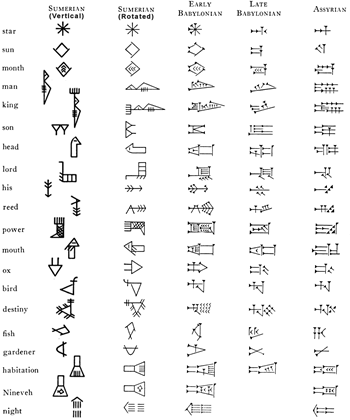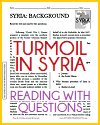Cuneiform writing. Translation: "I am Assurbanipal, descendant of Assur and Beltis." Assurbanipal was a king of Assyria. Click here to enlarge.
 Ancient cuneiform writing, one of the earliest systems of writing, originated in Mesopotamia around 3400 B.C.E. Developed by the Sumerians, this script was initially used for accounting and record-keeping but evolved to encompass various aspects of daily life, including legal, literary, and administrative documents.
Ancient cuneiform writing, one of the earliest systems of writing, originated in Mesopotamia around 3400 B.C.E. Developed by the Sumerians, this script was initially used for accounting and record-keeping but evolved to encompass various aspects of daily life, including legal, literary, and administrative documents.
Cuneiform, named for its wedge-shaped marks, was inscribed on clay tablets using a reed stylus. The script comprised a series of pictographs that gradually transformed into abstract symbols representing sounds or syllables, making it a versatile writing system capable of expressing complex ideas and narratives.
Over time, cuneiform was adopted and adapted by various cultures, including the Akkadians, Babylonians, Assyrians, and Hittites, each adding their modifications and contributions. This widespread use underscores cuneiform's significance in the ancient world as a medium for communication and cultural exchange.
Cuneiform texts provide invaluable insights into the societies that used them, revealing information about their politics, economy, religion, and daily life. Notable cuneiform works include the Epic of Gilgamesh, one of the earliest known literary works, and the Code of Hammurabi, one of the first written legal codes. The study of cuneiform has been crucial for understanding the history and development of early civilizations in the Near East.
|

 Ancient cuneiform writing, one of the earliest systems of writing, originated in Mesopotamia around 3400 B.C.E. Developed by the Sumerians, this script was initially used for accounting and record-keeping but evolved to encompass various aspects of daily life, including legal, literary, and administrative documents.
Ancient cuneiform writing, one of the earliest systems of writing, originated in Mesopotamia around 3400 B.C.E. Developed by the Sumerians, this script was initially used for accounting and record-keeping but evolved to encompass various aspects of daily life, including legal, literary, and administrative documents.














